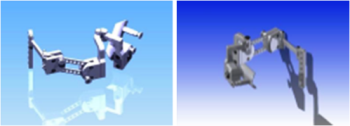Jan 22 2016
Researchers from UPM have developed an intelligent robotic system that improves the recovery of patients with shoulder injuries, a diseases that cause a high rate of sick leave.
 Exoskeleton designed by CAR (UPM-CSIC). / UPM.
Exoskeleton designed by CAR (UPM-CSIC). / UPM.
Researchers, from the Centre for Automation and Robotics (CAR, UPM-CSIC), have invented a robotic exoskeleton that efficiently performs rehabilitation therapies of shoulder injury patients. During the treatment process, the system uses motion and strength sensors to determine the condition of the back injury and its evolution during treatment.
This new robotic system can be used for all patients easily, this helps to ensure a speedy recovery for patients and assists healthcare providers who treat back injuries on a daily basis.
The human shoulder performs a wide range of motions and is considered to be one of the most complex joints in the body. The interrelationship of shoulder parts complicates rehabilitation in comparison to several other skeletal-muscle injuries.
It is suggested that recovery time for patients is reduced when using the intelligent robotic systems to carry out rehabilitation therapies. However, not many robotic systems have been developed to help in the recovery of patients with shoulder injuries. As a result of this, CAR researchers have invented a robotic exoskeleton that reduces the recovery time of injuries and also monitors and registers the advancement of the rehabilitation process.
Cecilia García Cena, a researcher from CAR, highlights that the exoskeleton can be developed by not just simulating the skeletal system, but also taking into account the dynamics and kinematics of an entire model by considering the ligaments, tendons, muscles, and the skeletal system. The new intelligent robotic system comprises all of these essential elements.
The new intelligent robotic system has a simple operating procedure and is inexpensive and suitable for all patients. The robotic system also uplifts the functioning of diminishing rehabilitation units, helping to save the healthcare system.